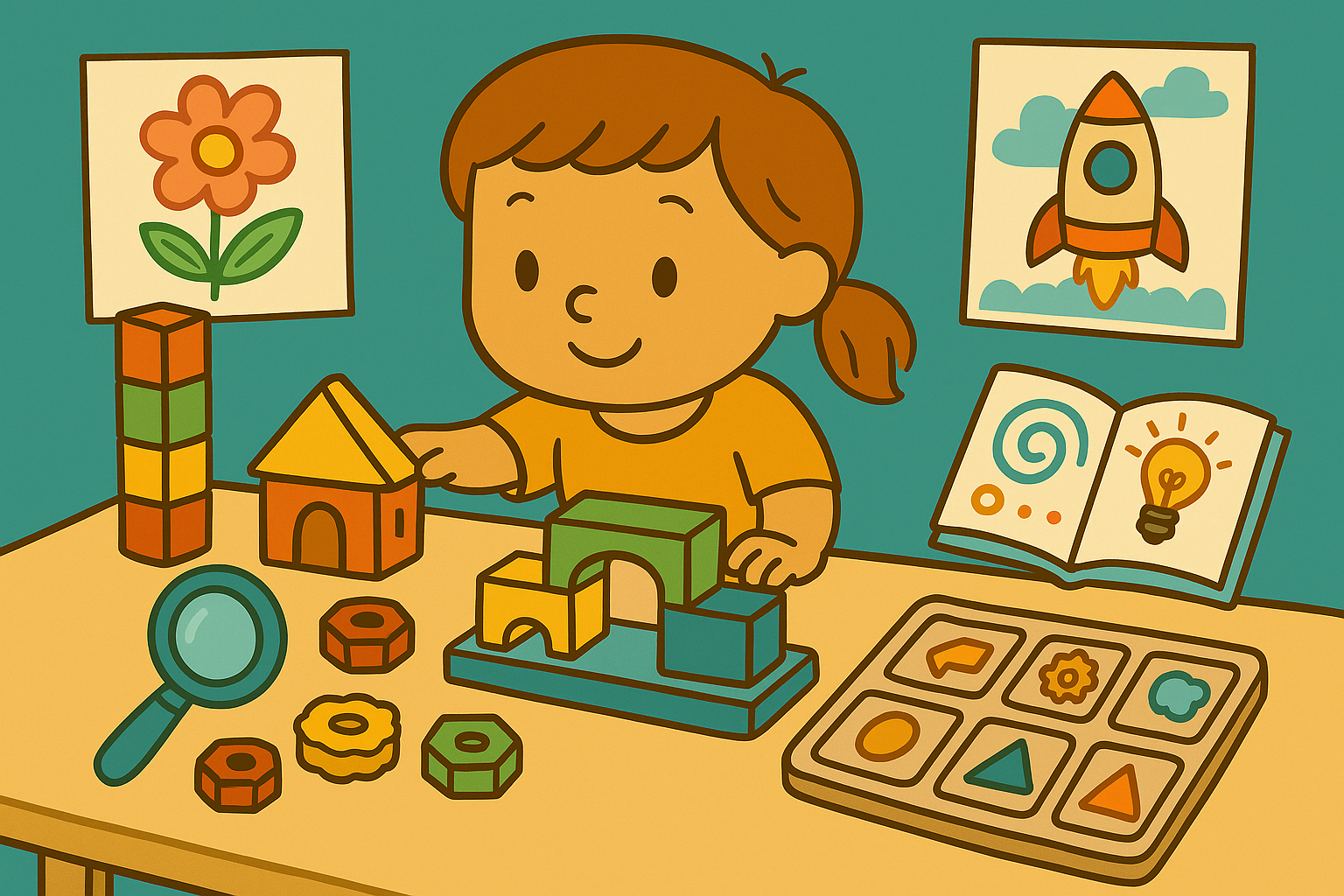The Link Between Play and Early STEM Skills
The Link Between Play and Early STEM Skills
How Play Naturally Builds the Foundation for STEM Thinking
STEM learning—science, technology, engineering, and math—may sound advanced for toddlers and preschoolers, but the truth is young children build these skills long before they ever encounter formal lessons. They learn STEM concepts through hands-on exploration, experimentation, imitation, and curiosity-driven play.
When a child stacks blocks, sorts leaves, mixes water and sand, builds roads, compares sizes, or asks “why?” for the hundredth time, they’re doing exactly what scientists and engineers do: observe, question, test, revise, and discover. Play is not separate from STEM—it is STEM.
How Curiosity Turns Daily Play Into Scientific Discovery
Toddlers and preschoolers are natural scientists. They poke, pour, stir, shake, drop, squeeze, and examine everything within reach. This instinctive curiosity drives early scientific thinking.
Through experimentation, children begin to understand:
Cause and effect
Patterns in nature
Simple physics (gravity, weight, motion)
Differences in texture, temperature, and material
Properties of liquids and solids
This kind of child-led discovery mirrors the open-ended exploration described in The Role of Free Exploration in Cognitive Development, where curiosity fuels learning without direct instruction.
Everyday Play Materials That Boost STEM Learning Without Effort
Parents don’t need special toys to promote STEM. Many of the best materials are already at home.
Great STEM-rich options include:
Blocks and stacking toys
Water pitchers, cups, funnels, and scoops
Cardboard tubes and recycled containers
Leaves, rocks, sticks, pinecones
Balls of different sizes and weights
Magnets, metal lids, and trays
Playdough, clay, and kinetic sand
These materials encourage children to explore shapes, balance, quantity, stability, and change—all key STEM concepts.
Building Early Engineering Skills Through Construction Play
When children build, they’re doing far more than creating tall towers. They are practicing engineering. Through trial and error, they discover which shapes balance, how to reinforce structures, and what causes things to fall.
You can support engineering thinking by:
Offering a variety of building materials
Encouraging attempts after collapses
Asking, “What could make it stronger?”
Allowing large-scale builds that last multiple days
This mirrors ideas from Using Play to Teach Basic Engineering Concepts, where building becomes a gateway to problem-solving skills.
How Sorting, Matching, and Patterning Strengthen Mathematical Thinking
Math begins long before numbers. Young children experience mathematical thinking through organizing, comparing, and predicting.
Offer activities like:
Sorting objects by size, color, or category
Making patterns with beads, stones, or blocks
Comparing which container holds more
Predicting which objects will sink or float
Matching shapes or lids to containers
These natural early-math experiences form the foundation for later numeracy and logical reasoning.
Encouraging Technology Exploration Through Hands-On Inquiry
Technology for young children doesn’t mean screens. At its core, technology is the study of tools and how humans use them.
Children practice early tech thinking when they:
Explore how simple tools work
Use scissors or hole punchers
Try out funnels and ladles
Build machines from recycled parts
Experiment with light tables or mirrors
Allowing hands-on experimentation fosters confidence and curiosity around real-world technology.
Supporting Scientific Thinking Through Questions and Observation
Instead of providing answers, adults can guide kids toward discovery by asking open-ended questions. This strengthens inquiry skills and encourages deeper understanding.
Try prompts like:
“What do you notice?”
“What do you think will happen next?”
“Why do you think that happened?”
“How could we test that idea?”
“What else could we try?”
This scientific dialogue aligns beautifully with the experimentation mindset in Creative Challenges for Growing Minds, where questioning is part of the learning process.
The Role of Dramatic Play in Strengthening STEM Concepts
Pretend play may not look like STEM at first, but it’s full of rich cognitive development. Children use logic, problem-solving, and symbolic thinking when they imagine and enact scenarios.
Examples include:
Running a pretend grocery store (sorting, counting, categorizing)
Building a vet clinic (problem-solving, sequencing)
Imagining construction sites (engineering, planning)
Exploring space travel with cardboard rockets (physics, storytelling)
Dramatic play blends creativity with structured thinking—just like real-world STEM work.
Outdoor Play as the Ultimate STEM Classroom
Nature is the richest learning laboratory for young children. Outdoor environments provide endless opportunities for observation, experimentation, and discovery.
Encourage activities like:
Studying insects or feathers
Following water flow with sticks
Testing which rocks roll vs. slide
Building mud dams
Exploring shadows and sunlight angles
These moments connect to the nature-based creativity highlighted in The Role of Nature in Creative Development, where outdoor environments deepen cognitive engagement.
Helping Kids Cope With STEM Setbacks Through Encouragement and Curiosity
STEM learning is full of trial and error. Towers fall. Bridges break. Predictions fail. These “mistakes” are opportunities for resilience.
Support children through:
Gentle encouragement
Celebrating attempts, not outcomes
Modeling calm reaction to accidents
Asking, “What could we try differently?”
Emphasizing the fun of experimenting
This mindset parallels the growth-focused approach in Encouraging Resilience Through Failed Creations, where setbacks become stepping stones.
Making STEM-Infused Play a Joyful Part of Family Life
You can build a playful STEM culture at home without formal lessons or specialized activities. Small daily routines make STEM feel accessible and exciting.
Try:
Weekly building challenges
“Mystery materials” exploration baskets
A nature-collection shelf
Water play Wednesdays
Family puzzle times
Evening shadow experiments
Rotating STEM trays (magnets, ramps, tubes)
Children learn best when STEM is woven into the rhythm of daily life—not something reserved for school. Over time, these experiences nurture curious thinkers who ask questions boldly, explore fearlessly, and see themselves as inventors, builders, and problem-solvers.
This content is for educational purposes and is not a substitute for professional medical or psychological advice.
Popular Parenting Articles


